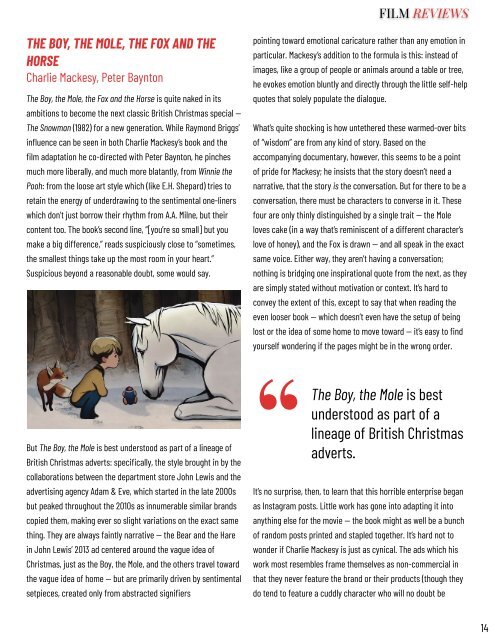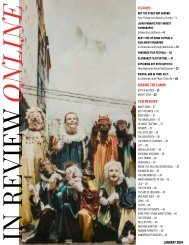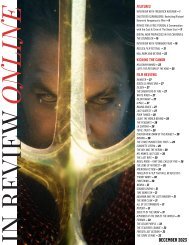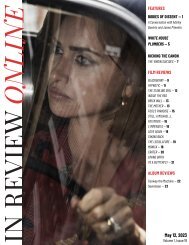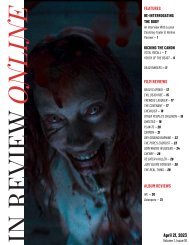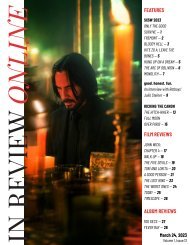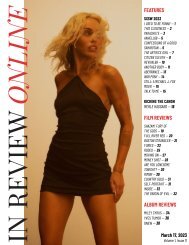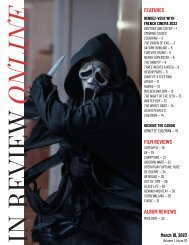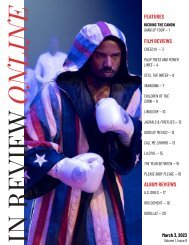InRO Weekly — Volume 1, Issue 1
You also want an ePaper? Increase the reach of your titles
YUMPU automatically turns print PDFs into web optimized ePapers that Google loves.
FILM REVIEWS<br />
THE BOY, THE MOLE, THE FOX AND THE<br />
HORSE<br />
Charlie Mackesy, Peter Baynton<br />
The Boy, the Mole, the Fox and the Horse is quite naked in its<br />
ambitions to become the next classic British Christmas special <strong>—</strong><br />
The Snowman (1982) for a new generation. While Raymond Briggs’<br />
influence can be seen in both Charlie Mackesy’s book and the<br />
film adaptation he co-directed with Peter Baynton, he pinches<br />
much more liberally, and much more blatantly, from Winnie the<br />
Pooh: from the loose art style which (like E.H. Shepard) tries to<br />
retain the energy of underdrawing to the sentimental one-liners<br />
which don’t just borrow their rhythm from A.A. Milne, but their<br />
content too. The book’s second line, “[you’re so small] but you<br />
make a big difference,” reads suspiciously close to “sometimes,<br />
the smallest things take up the most room in your heart.”<br />
Suspicious beyond a reasonable doubt, some would say.<br />
pointing toward emotional caricature rather than any emotion in<br />
particular. Mackesy’s addition to the formula is this: instead of<br />
images, like a group of people or animals around a table or tree,<br />
he evokes emotion bluntly and directly through the little self-help<br />
quotes that solely populate the dialogue.<br />
What’s quite shocking is how untethered these warmed-over bits<br />
of “wisdom” are from any kind of story. Based on the<br />
accompanying documentary, however, this seems to be a point<br />
of pride for Mackesy; he insists that the story doesn’t need a<br />
narrative, that the story is the conversation. But for there to be a<br />
conversation, there must be characters to converse in it. These<br />
four are only thinly distinguished by a single trait <strong>—</strong> the Mole<br />
loves cake (in a way that’s reminiscent of a different character’s<br />
love of honey), and the Fox is drawn <strong>—</strong> and all speak in the exact<br />
same voice. Either way, they aren’t having a conversation;<br />
nothing is bridging one inspirational quote from the next, as they<br />
are simply stated without motivation or context. It’s hard to<br />
convey the extent of this, except to say that when reading the<br />
even looser book <strong>—</strong> which doesn’t even have the setup of being<br />
lost or the idea of some home to move toward <strong>—</strong> it’s easy to find<br />
yourself wondering if the pages might be in the wrong order.<br />
But The Boy, the Mole is best understood as part of a lineage of<br />
British Christmas adverts: specifically, the style brought in by the<br />
collaborations between the department store John Lewis and the<br />
advertising agency Adam & Eve, which started in the late 2000s<br />
but peaked throughout the 2010s as innumerable similar brands<br />
copied them, making ever so slight variations on the exact same<br />
thing. They are always faintly narrative <strong>—</strong> the Bear and the Hare<br />
in John Lewis’ 2013 ad centered around the vague idea of<br />
Christmas, just as the Boy, the Mole, and the others travel toward<br />
the vague idea of home <strong>—</strong> but are primarily driven by sentimental<br />
setpieces, created only from abstracted signifiers<br />
“The Boy, the Mole is best<br />
understood as part of a<br />
lineage of British Christmas<br />
adverts.<br />
It’s no surprise, then, to learn that this horrible enterprise began<br />
as Instagram posts. Little work has gone into adapting it into<br />
anything else for the movie <strong>—</strong> the book might as well be a bunch<br />
of random posts printed and stapled together. It’s hard not to<br />
wonder if Charlie Mackesy is just as cynical. The ads which his<br />
work most resembles frame themselves as non-commercial in<br />
that they never feature the brand or their products (though they<br />
do tend to feature a cuddly character who will no doubt be<br />
14


